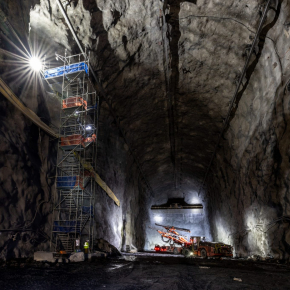Excavation of caverns for DUNE experiment completed
After more than two years' work, the giant underground caverns for the DUNE neutrino experiment have been completed at the Sanford Underground Research Laboratory in South Dakota (USA). They will house huge detectors that will materialize the passage of the intense neutrinos beams 1300 km further east at the American Fermilab laboratory. The collaboration, in which IN2P3 plays a major role, is now preparing to install the technical infrastructure for these underground cathedrals, with a view to commissioning the first of the four planned detectors by 2028.
The international DUNE experiment, conducted at Fermilab and involving over 200 institutions in 36 countries, including several IN2P3 laboratories, has reached a crucial milestone. In January, contractor Thyssen Mining finished clearing the last cubic meters of rock from three caverns at the Sanford Underground Research Laboratory (SURF) site, on the outskirts of the small town of Lead, South Dakota. 1500 meters below the surface of this former mining site, these immense caverns - the largest of which being 28m high by 190m long and 21m wide - are ready to receive, in the coming years, the four modules of the far detector, the centerpiece of the DUNE project.
The dimensions of the three caverns are commensurate with their future contents. In the first phase, the far detector will comprise two giant modules, each 60m long and containing around 17 000 tonnes of liquid argon. Ultimately, with four modules, DUNE's far detector will be the world's largest and most technologically advanced liquid argon neutrino detector, more than 20 times larger than existing detectors of this type. It will observe with unrivalled precision neutrinos emitted by a particle accelerator (PIP II) located in the Fermilab complex 1300 kilometers away. This remote measurement will be complemented by a "near" detection enabling scientists to accurately measure the oscillation of neutrinos on their journey.
IN2P3 is one of the U.S. Department of Energy's (DOE) main partners in the DUNE project, following the signing of an agreement with Fermilab in November 2023. Through this agreement, six of the institute's laboratories (APC, IJCLab, IP2I, LAPP, LPSC, LP2iB) have committed to making contributions to the detector, which will implement the so-called "vertical drift" technology on a very large scale. This technology, inspired in particular by research and development work carried out at IN2P3 over the past 15 years, was recently validated at CERN as part of a reduced-scale prototype of the DUNE experiment. In addition, French laboratories will participate in the construction of the PIP II particle accelerator, while the IN2P3 computing center will contribute to the experiment's overall storage and computing capacity.
Click here to read Fermilab's press release.
